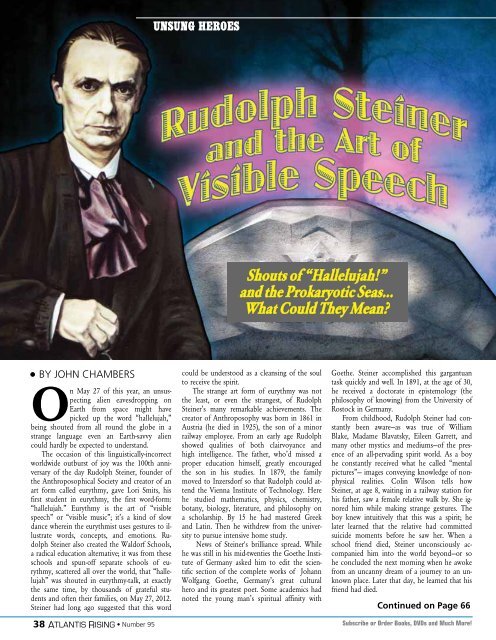Do We Know What We Think We Know About ... - TheUFOStore.com
Do We Know What We Think We Know About ... - TheUFOStore.com
Do We Know What We Think We Know About ... - TheUFOStore.com
Create successful ePaper yourself
Turn your PDF publications into a flip-book with our unique Google optimized e-Paper software.
• BY JOHN CHAMBERS<br />
On May 27 of this year, an unsuspecting<br />
alien eavesdropping on<br />
Earth from space might have<br />
picked up the word “hallelujah,”<br />
being shouted from all round the globe in a<br />
strange language even an Earth-savvy alien<br />
could hardly be expected to understand.<br />
The occasion of this linguistically-incorrect<br />
worldwide outburst of joy was the 100th anniversary<br />
of the day Rudolph Steiner, founder of<br />
the Anthroposophical Society and creator of an<br />
art form called eurythmy, gave Lori Smits, his<br />
first student in eurythmy, the first word-form:<br />
“hallelujah.” Eurythmy is the art of “visible<br />
speech” or “visible music”; it’s a kind of slow<br />
dance wherein the eurythmist uses gestures to illustrate<br />
words, concepts, and emotions. Rudolph<br />
Steiner also created the Waldorf Schools,<br />
a radical education alternative; it was from these<br />
schools and spun-off separate schools of eurythmy,<br />
scattered all over the world, that “hallelujah”<br />
was shouted in eurythmy-talk, at exactly<br />
the same time, by thousands of grateful students<br />
and often their families, on May 27, 2012.<br />
Steiner had long ago suggested that this word<br />
38 ATLANTIS RISING • Number 95<br />
UNSUNG HEROES<br />
Shouts Shouts of of “Hallelujah!”<br />
“Hallelujah!”<br />
and and the the Prokaryotic Prokaryotic Seas... Seas...<br />
<strong>What</strong> <strong>What</strong> Could Could They They Mean?<br />
Mean?<br />
could be understood as a cleansing of the soul<br />
to receive the spirit.<br />
The strange art form of eurythmy was not<br />
the least, or even the strangest, of Rudolph<br />
Steiner’s many remarkable achievements. The<br />
creator of Anthroposophy was born in 1861 in<br />
Austria (he died in 1925), the son of a minor<br />
railway employee. From an early age Rudolph<br />
showed qualities of both clairvoyance and<br />
high intelligence. The father, who’d missed a<br />
proper education himself, greatly encouraged<br />
the son in his studies. In 1879, the family<br />
moved to Inzersdorf so that Rudolph could attend<br />
the Vienna Institute of Technology. Here<br />
he studied mathematics, physics, chemistry,<br />
botany, biology, literature, and philosophy on<br />
a scholarship. By 15 he had mastered Greek<br />
and Latin. Then he withdrew from the university<br />
to pursue intensive home study.<br />
News of Steiner's brilliance spread. While<br />
he was still in his mid-twenties the Goethe Institute<br />
of Germany asked him to edit the scientific<br />
section of the <strong>com</strong>plete works of Johann<br />
Wolfgang Goethe, Germany’s great cultural<br />
hero and its greatest poet. Some academics had<br />
noted the young man’s spiritual affinity with<br />
Goethe. Steiner ac<strong>com</strong>plished this gargantuan<br />
task quickly and well. In 1891, at the age of 30,<br />
he received a doctorate in epistemology (the<br />
philosophy of knowing) from the University of<br />
Rostock in Germany.<br />
From childhood, Rudolph Steiner had constantly<br />
been aware—as was true of William<br />
Blake, Madame Blavatsky, Eileen Garrett, and<br />
many other mystics and mediums—of the presence<br />
of an all-pervading spirit world. As a boy<br />
he constantly received what he called “mental<br />
pictures”— images conveying knowledge of nonphysical<br />
realities. Colin Wilson tells how<br />
Steiner, at age 8, waiting in a railway station for<br />
his father, saw a female relative walk by. She ignored<br />
him while making strange gestures. The<br />
boy knew intuitively that this was a spirit; he<br />
later learned that the relative had <strong>com</strong>mitted<br />
suicide moments before he saw her. When a<br />
school friend died, Steiner unconsciously ac<strong>com</strong>panied<br />
him into the world beyond—or so<br />
he concluded the next morning when he awoke<br />
from an uncanny dream of a journey to an unknown<br />
place. Later that day, he learned that his<br />
friend had died.<br />
Continued on Page 66<br />
Subscribe or Order Books, DVDs and Much More!


